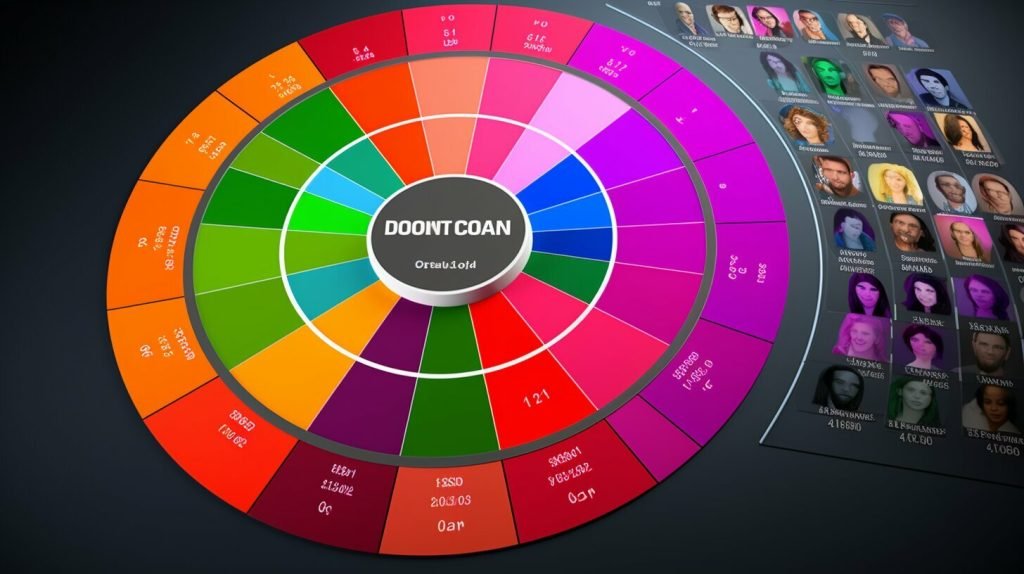In today’s digital age, it’s important to adopt effective promotional strategies to cut through the clutter and stand out from the competition. Public relations and media outreach have emerged as essential tools for boosting brand visibility and engagement. By leveraging these strategies, businesses can create a powerful narrative and enhance their credibility among their target audience.
Digital marketing has opened new communication channels, making it easier to reach the intended audience. However, traditional media outlets still play a significant role in amplifying advertising efforts. This section will delve into the importance of promotional strategies, with a focus on public relations and media outreach. It will highlight the role of these strategies in brand-building and provide insights into effective ways to reach out to the target audience.
Key Takeaways:
- Public relations and media outreach are essential promotional strategies for boosting brand visibility and engagement.
- Digital marketing provides various communication channels to reach the target audience effectively.
- Traditional media outlets still play a significant role in amplifying advertising efforts.
- The use of well-crafted press kits, strong media relations, and effective pitching strategies can enhance media coverage.
Understanding Public Relations in Promotional Strategies
Public relations is a vital component of promotional strategies. It refers to the practice of managing communication between an organization and its stakeholders to build and maintain a positive brand image. Effective public relations strategies can enhance brand credibility, establish trust, and improve reputation management.
One of the key objectives of public relations is to create a positive perception of a brand. This is achieved through various communication tactics such as media relations, community engagement, and crisis management. Media relations involve building relationships with journalists and publications to secure media coverage.
“Public Relations is a strategic communication process that builds mutually beneficial relationships between organizations and their publics.”
– Public Relations Society of America (PRSA)
Press releases are also an essential tool for disseminating key messages to the target audience. A well-crafted press release can generate media interest and increase the likelihood of media coverage. Moreover, public relations can help organizations manage crises effectively by communicating proactively and transparently with stakeholders.
Through public relations, organizations can also communicate their core values, mission, and vision, which can create an emotional connection with the target audience. A strong brand identity can result in increased brand loyalty and customer retention. Therefore, public relations is a crucial element in creating and maintaining a positive brand image.

Role of Public Relations in Reputation Management
Public relations is integral to managing a brand’s reputation. By communicating proactively with stakeholders, public relations can help organizations address potential issues before they escalate into crises. In turn, this can prevent potential damage to the brand’s image and reputation.
Through effective reputation management, public relations can mitigate negative publicity and promote positive news coverage. This, in turn, can lead to increased brand visibility and improved audience engagement.
Harnessing the Power of Media Outreach
Media outreach is a critical component of promotional strategies that can help businesses reach a wider audience and enhance brand visibility. This section will discuss effective strategies for media outreach, including building media contacts, fostering relationships with journalists, pitching stories, and creating press kits. It will also highlight the importance of media coverage in achieving promotional objectives.
Building Media Contacts
Building media contacts is essential for successful media outreach. Journalists receive numerous pitches daily, making it crucial to establish a personal relationship with them. Research relevant journalists and their areas of interest to ensure that the pitch is tailored to their preferences. Social media platforms, such as LinkedIn and Twitter, can be effective tools for identifying and engaging with journalists.
Fostering Relationships with Journalists
Fostering relationships with journalists can enhance the chances of a successful media outreach campaign. Regularly engage with journalists by commenting on their articles and stories, and offering valuable insights. Building rapport with journalists can lead to increased coverage and provide opportunities for future collaborations.
Pitching Stories
Pitching stories to journalists requires a well-crafted message that is relevant and newsworthy. The pitch should highlight the value of the story and why it is of interest to the journalist’s audience. Personalizing the pitch and providing exclusive content can increase the likelihood of coverage.
Creating Press Kits
Press kits are a collection of materials that can be used to introduce the business to journalists and the media. These materials often include a company overview, press releases, fact sheets, and images. Creating a comprehensive press kit can make it easier for journalists to craft their stories and increase the chances of favorable coverage.
Image source: 
Integrating Public Relations and Media Outreach into Marketing Campaigns
Effective marketing campaigns require a comprehensive and integrated approach that incorporates various promotional strategies. Public relations and media outreach are essential components that can significantly enhance the impact of marketing efforts.
Integrating public relations and media outreach into marketing campaigns allows for cohesive messaging across different channels. This approach ensures that the brand’s core values and objectives are communicated consistently through various communication channels, increasing the overall impact of the campaign.
Benefits of Integrating Public Relations and Media Outreach
- Increased brand visibility and awareness
- Enhanced credibility and trust with the target audience
- Expanded target audience reach through media coverage
- Opportunities for increased engagement with customers and stakeholders
Furthermore, the use of public relations and media outreach can help achieve the objectives of a marketing campaign. PR efforts can help establish the brand’s image and reputation, while media outreach can increase exposure and generate buzz around the campaign.
Strategies for Integrating Public Relations and Media Outreach
Integrating public relations and media outreach is a multi-step process that involves aligning the messaging and tactics of each strategy with the overall marketing campaign objectives. Here are some strategies to consider:
| Strategy | Description |
|---|---|
| Develop a comprehensive PR plan | Create a plan that outlines key messages, target audiences, and tactics for building media relations and generating coverage. |
| Create a media kit | Develop a media kit that includes press releases, company information, and key spokespeople bios to distribute to journalists and media outlets. |
| Engage in influencer marketing | Partner with relevant influencers to help reach new audiences and generate buzz around the campaign. |
| Leverage social media | Use social media platforms to promote the campaign, engage with customers, and share media coverage. |
Integrating public relations and media outreach into a marketing campaign can help maximize the impact of promotional efforts. By combining these strategies with other promotional tactics like digital marketing, businesses can effectively communicate their message and achieve their marketing campaign objectives.

Leveraging Digital Marketing in Promotional Strategies
Digital marketing has revolutionized how businesses promote their products and services. In today’s digital age, online platforms provide vast opportunities for businesses to reach their target audience more effectively and efficiently.
Social media is a powerful tool for brand promotion, with billions of users actively engaging with various platforms daily. By creating engaging social media content, businesses can increase their brand visibility, attract new customers, and retain existing ones.
Content marketing is another effective strategy in digital marketing. It involves creating and distributing valuable content that resonates with the target audience. This content can be in various forms, such as blog posts, videos, webinars, e-books, and more.
Search engine optimization (SEO) is also essential in digital marketing. By optimizing website content and structure, businesses can rank higher in search results and attract more organic traffic to their website.
Influencer marketing is another trend in digital marketing, which involves collaborating with influencers to promote products or services to their followers. By leveraging the influencer’s reach and credibility, businesses can expand their audience and increase sales.

When it comes to digital marketing, it’s crucial to choose the right channels and strategies that align with the business’s goals and target audience. By utilizing digital marketing effectively, businesses can enhance their promotional strategies and achieve greater success.
Identifying Target Audience for Promotional Strategies
One of the most crucial aspects of any promotional strategy is identifying the target audience. Marketing efforts that fail to resonate with the intended audience can quickly become a wasted investment. Therefore, customer segmentation and market research play a crucial role in developing tailored messaging that effectively engages with the target audience.
Demographics, psychographics, and consumer behavior are all critical factors to consider when identifying the target audience. Demographics include age, gender, income level, education level, and geographic location. Psychographics, on the other hand, refer to attitudes, values, interests, and lifestyle choices. Understanding consumer behavior, such as purchasing habits and brand preferences, can also provide valuable insights into audience preferences.
The use of customer relationship management (CRM) tools and data analytics can help identify the target audience and track their behavior and preferences. By using this information, businesses can create promotional messages that resonate with their audience, ultimately resulting in better engagement and conversion rates.

Image description: A target audience dartboard with different sections representing a diverse audience.
Measuring the Success of Promotional Strategies
Measuring the success of promotional strategies is crucial for businesses to evaluate the effectiveness of their advertising efforts and adjust their approach accordingly. Defining success metrics and key performance indicators (KPIs) is vital to track progress and determine the return on investment (ROI).
Analytics tools and data analysis provide businesses with valuable insights into consumer behavior and engagement with promotional content. By analyzing data, businesses can identify patterns and trends in their promotional strategies, helping them to make informed decisions about future campaigns.
| Success Metrics | KPIs |
|---|---|
| Brand Awareness | Impressions, Reach, Share of Voice |
| Engagement | Click-Through Rates, Likes, Comments, Shares |
| Conversion | Sales, Leads, Sign-Ups |
Businesses should establish KPIs that align with their promotional objectives and monitor them regularly to evaluate performance. By continuously tracking success metrics and KPIs, businesses can adjust their promotional strategies to optimize their advertising efforts.
According to a study by HubSpot, companies that measure their marketing campaigns are 12 times more likely to generate a positive ROI than those that don’t.

Measuring the success of promotional strategies is an ongoing process that requires regular analysis and adjustment. By utilizing analytics tools and monitoring KPIs, businesses can stay on top of their advertising efforts and make informed decisions that lead to a positive ROI.
Adapting Promotional Strategies for Different Communication Channels
One of the key aspects of effective promotional strategies is adapting them for different communication channels. Traditional communication channels, such as television and print media, are still relevant in reaching specific audiences. However, online platforms have become increasingly important in recent years, due to the rise of digital marketing and social media.
When selecting communication channels, it is important to consider the target audience reach. Traditional media may be appropriate for targeting an older demographic, while online platforms may be more suitable for reaching a younger audience. Cross-channel marketing can also be effective in maximizing reach across different channels.
It is essential to tailor promotional messages to the specific communication channel. For example, online platforms may require shorter and more visually appealing messages, while traditional media may allow for more detailed messaging. Adapting promotional strategies for different communication channels ensures that the message resonates with the intended audience.

“Adapting promotional strategies for different communication channels ensures that the message resonates with the intended audience.”
Maximizing the Benefits of Promotional Strategies through Collaboration
Promotional strategies can achieve their maximum potential when combined with effective collaboration efforts. Strategic partnerships, co-marketing, sponsorships, and joint campaigns are all viable options for pooling resources and amplifying promotional reach.
One effective collaboration strategy is the establishment of strategic partnerships. By partnering with businesses that share similar values and target audiences, companies can leverage each other’s strengths to create a mutually beneficial promotional campaign. For example, a fitness apparel company might partner with a health food store to create a campaign promoting healthy lifestyles.
Co-marketing efforts can also be an effective collaboration tool, where two or more businesses work together to promote their products or services. This strategy not only helps to increase brand awareness but also fosters a sense of community and shared purpose among the brands’ respective audiences.
Sponsorships are another excellent way to maximize promotional benefits through collaboration. By sponsoring an event or organization, companies can gain exposure to a wider audience while also supporting a cause or community. For example, a clothing company might sponsor a music festival to reach a young, fashion-forward audience.
Joint campaigns, where multiple companies collaborate to create a single, unified promotional effort, can be a powerful way to share resources and reach a wider audience. This strategy allows companies to combine their strengths and create a cohesive message that speaks to the shared interests and values of their target audiences.
Overall, collaboration is essential for companies looking to maximize the benefits of their promotional strategies. By partnering with other businesses, pooling resources, and sharing target audiences, companies can achieve greater promotional success and reach a broader audience.

Conclusion
In today’s competitive business landscape, promoting a brand effectively is crucial for success. Public relations and media outreach are powerful promotional strategies that can help businesses boost brand visibility and engagement. By establishing strong media relations, pitching compelling stories, and crafting effective press releases, businesses can leverage the power of media outreach to reach their target audience.Integrating public relations and media outreach into marketing campaigns can help create a cohesive message and achieve campaign objectives. When combined with digital marketing strategies such as social media, content marketing, and influencer marketing, businesses can maximize the benefits of promotional strategies and reach a wider audience.To create effective promotional strategies, businesses must first identify their target audience. By conducting market research and understanding the demographics, psychographics, and behavior of their audience, businesses can tailor their promotional messages to effectively engage with their target audience.Once promotional strategies are implemented, it is essential to measure their success. Defining success metrics, establishing key performance indicators (KPIs), and using analytics tools can help businesses track and measure their return on investment (ROI).Adapting promotional strategies for different communication channels, such as traditional media and online platforms, can help businesses reach their target audience where they are most likely to engage. Collaboration through strategic partnerships, co-marketing efforts, sponsorships, and joint campaigns can also help businesses maximize their promotional reach.In conclusion, by incorporating these various promotional strategies and tactics into their overall marketing plan, businesses can effectively promote their brand and engage with their target audience, leading to increased success and growth.How Can Online Advertising Help in the Success of Promotional Strategies?
Online and offline advertising success go hand in hand when it comes to promoting strategies. Online advertising boosts visibility and reaches a wider audience through targeted ads, social media campaigns, and search engine optimization. Offline advertising, on the other hand, complements this by engaging with customers through print media, direct mail, and outdoor advertising. The combination of these approaches allows businesses to effectively reach their target market and enhance their overall promotional strategies.
FAQ
Q: What are promotional strategies?
A: Promotional strategies are techniques and tactics used to increase brand visibility and engage with the target audience. They can include various marketing campaigns and communication channels to effectively promote a product, service, or brand.
Q: How does public relations contribute to promotional strategies?
A: Public relations plays a crucial role in promotional strategies by helping build a positive brand image and managing reputation. It utilizes communication tactics, media relations, and press releases to disseminate key messages to the target audience.
Q: What is the significance of media outreach in promotional strategies?
A: Media outreach is essential in promotional strategies as it enables brands to connect with journalists, pitch stories, and secure media coverage. It helps enhance brand visibility and reach a wider audience.
Q: How can public relations and media outreach be integrated into marketing campaigns?
A: Public relations and media outreach can be integrated into marketing campaigns by aligning messaging across different channels. This ensures a cohesive and consistent brand image and helps achieve campaign objectives.
Q: What role does digital marketing play in promotional strategies?
A: Digital marketing is a crucial component of promotional strategies. It leverages online platforms such as social media, content marketing, SEO, and influencer marketing to enhance brand visibility and engage with the target audience.
Q: How important is identifying the target audience in promotional strategies?
A: Identifying the target audience is vital in promotional strategies as it enables brands to tailor their messages and effectively engage with the intended audience. Customer segmentation and market research help understand demographics, psychographics, and consumer behavior.
Q: How can the success of promotional strategies be measured?
A: The success of promotional strategies can be measured by defining success metrics and establishing key performance indicators (KPIs). Analytics tools and data analysis help track and measure the return on investment (ROI).
Q: Why is it necessary to adapt promotional strategies for different communication channels?
A: Adapting promotional strategies for different communication channels ensures reaching the target audience through traditional media and online platforms. Cross-channel marketing allows brands to maximize their reach and engage with a broader audience.
Q: What are the benefits of collaboration in promotional strategies?
A: Collaboration in promotional strategies brings several benefits, including forming strategic partnerships, engaging in co-marketing efforts, and seeking sponsorships. Joint campaigns allow brands to pool resources and share target audiences, amplifying promotional reach.

